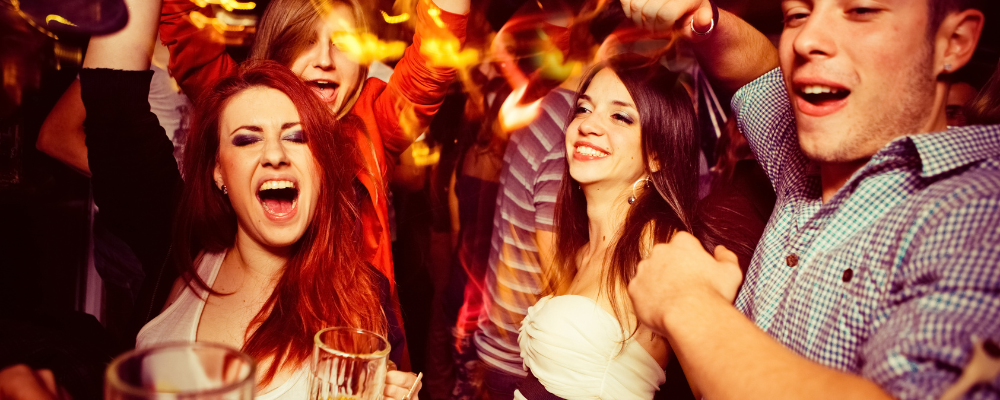Dancing on the bars, $10 all-you-can-drink specials, bartenders doing shots with you and pouring shots directly in your mouth from the bottle - What’s not to love about going to a club like this? While this may be a place that can show you a good time, from an Underwriting perspective, each one of these exposures is a reason NOT to write the risk.
When our Underwriters look at a submission, they consider many different aspects and exposures of the risk and determine if there are nightclub characteristics that would require additional underwriting. This information is gathered from the application, social media searches, and a supplemental application with questions specific to the exposure.
What are nightclub characteristics? ICC generally avoids labeling or classifying a risk as a nightclub since that classification can have different connotations for different people. To appropriately rate for this risk, ICC focuses the submission discussion on nightclub characteristics:
- Dance floor
- Door security
- Live music or DJ
- Cover charge
Typically, Underwriting will request additional information to determine the exposure and apply proper rating. This is another example of how ICC can produce stable pricing for risks many carriers would not even consider.
Additional risk evaluation factors include:
- Clientele and location – These factors can make a world of difference in determining the exposure of the risk. Is the risk located in a high crime area? Is it near a college? Based on advertising, what type of clientele are they trying to attract? The type of patrons at the nightclub can greatly impact the exposure.
- Security/Bouncers – Security personnel are important to have, especially in a busy bar environment. However, we have seen an increase in security-related claims over recent years, so training is extremely important. Some key things to look for:
- Are security personnel employees, independent contractors, or provided by a security firm? If they have an outside security firm, there must be a contract in place that holds the insured harmless from any injury caused by the security firm employees. The security firm must provide a certificate of insurance with liability limits equal to those of the insured.
- What type of training is required of security personnel? There should be formal training, including training on how to handle emergency evacuations. If the applicant/insured does not have written procedures that are enforced by management, this may not be an acceptable account.
- Do they have an age identification system in place?
- What are the procedures for checking for weapons? The most common procedure is wanding. Some risks have walk-through systems like those at airports. Being “patted down” is a poor choice since this could result in harassment charges.
- What “tools”, if any, do personnel have, (e.g., mace, billy club, gun or other weapon, restraint devices)? Most weapons or restraint devices are not acceptable unless the security personnel is an off-duty police officer.
- Security Cameras – Security footage can provide valuable documentation to determine liability at the time of a claim, and cameras may act as a deterrent if they are visible or there is signage indicating that cameras are being utilized. Important considerations are:
- How much of the interior and exterior is covered by the cameras?
- How long is the data retained? Many liability claims are not made until 12 to 24 months after an incident.
- Hours of operation – Whoever coined the statement “nothing good happens after midnight” was right! We understand that most nightclubs do not close by midnight, but our experience shows that closing hours past 2 a.m. greatly increase the likeliness of an incident occurring. We will, however, write risks that close later than 2 a.m. if they have proper alcohol server training and security training.
- Entertainment – DJs and dancing are to be expected in a nightclub, but does the entertainment involve pyrotechnics, mosh pits, MMA type events, etc.? Entertainment can draw in customers, but those mentioned can increase the risk significantly and are undesirable.
- Promotions – Much like entertainment, promotions are meant to bring in more patrons than normal. People tend to both eat and drink more during promotions because they are getting the same thing at a lower cost. Advertising drink specials like 2 for 1’s or all-you-can-drink for a specified dollar amount promote excessive drinking and are unacceptable for us to write the risk. They also understate the receipts, so we are not able to get the proper rate for the exposure.
- Alcohol server training – Many states have recognized the importance of alcohol training, and some have made it mandatory to keep a liquor license. It is important that bar and restaurant employees are educated on how to responsibly serve alcohol and recognize those that are intoxicated.
Nightclubs are typically high profile and high premium accounts and can be a great addition to your (and our) book of business if they have the right controls and management. For more information about ICC’s program for nightclubs, visit our Nightclub Insurance Program page.





